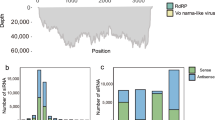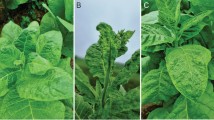Abstract
Contigs with sequence homologies to cherry-associated luteovirus were identified by high-throughput sequencing analysis in two peach accessions. Complete genomic sequences of the two isolates of this virus were determined to be 5,819 and 5,814 nucleotides long, respectively. The genome of the new virus is typical of luteoviruses, containing eight open reading frames in a very similar arrangement. Its genomic sequence is 58-74% identical to those of other members of the genus Luteovirus. These sequences thus belong to a new virus, which we have named “peach-associated luteovirus”.


Similar content being viewed by others
References
Barba M, Ilardi V, Pasquini G (2015) Control of pome and stone fruit virus diseases. Adv Virus Res 91:47–83
Ali M, Hameed S, Tahir M (2014) Luteovirus: insights into pathogenicity. Arch Virol 159:2853–2860
Domier LL (2012) Luteoviridae. In: King AMQ, Adams MJ, Carstens EB, Lefkowitz EJ (eds) Virus taxonomy, ninth report of the International Committee on Taxonomy of Viruses. Elsevier Academic Press, pp 1045–1053
Salem NM, Miller WA, Rowhani A, Deborah AG, Moyne A-L, Falk BW (2008) Rose spring dwarf-associated virus has RNA structural and gene-expression features like those of Barley yellow dwarf virus. Virology 375:354–360
Villamor DEV, Mekuria TA, Pillai SS, Eastwell KC (2016) High-throughput sequencing identifies novel virus in nectarine: insights to the etiology of stem-pitting disease. Phytopathology 106:519–527
Lenz O, Pˇribylova J, Fra´nova´ J, Koloniuk I, Spak J (2016) Identification and characterization of a new member of the genus Luteovirus from cherry . Arch Virol (on line)
Miller A, Jackson J, Feng Y (2015) Cis- and trans-regulation of luteovirus gene expression by the 3’ end of the viral genome. Virus Res 206:37–45
Smirnova E, Firth AE, Miller WA, Scheidecker D, Brault V, Reinbold C, Rakotondrafara AM., Chung BYW, Ziegler-Graff V (2015) Discovery of a small non-AUG-initiated ORF in poleroviruses and luteoviruses that is required for long-distance movement. PLoS Pathog, ppat.1004868
Author information
Authors and Affiliations
Corresponding author
Ethics declarations
All authors declare that they have no conflict of interest. This study did not contain any research involving human or animal participants. Plant samples were imported under USDA-APHIS permit P526P-15-01082.
Electronic supplementary material
Below is the link to the electronic supplementary material.
Rights and permissions
About this article
Cite this article
Wu, LP., Liu, HW., Bateman, M. et al. Molecular characterization of a novel luteovirus from peach identified by high-throughput sequencing. Arch Virol 162, 2903–2905 (2017). https://doi.org/10.1007/s00705-017-3388-z
Received:
Accepted:
Published:
Issue Date:
DOI: https://doi.org/10.1007/s00705-017-3388-z




